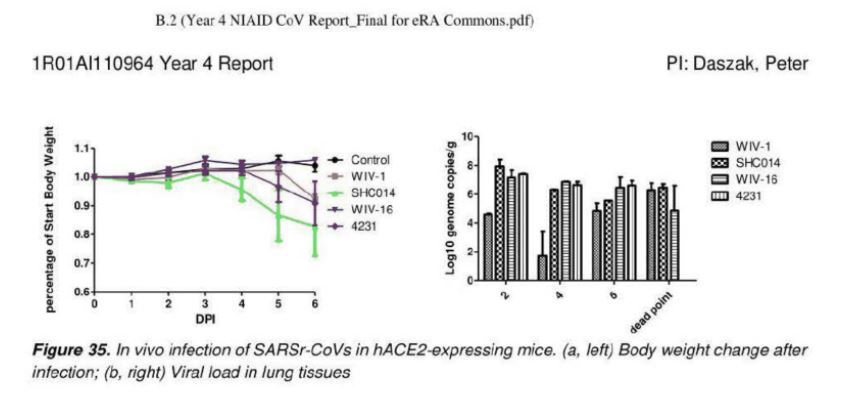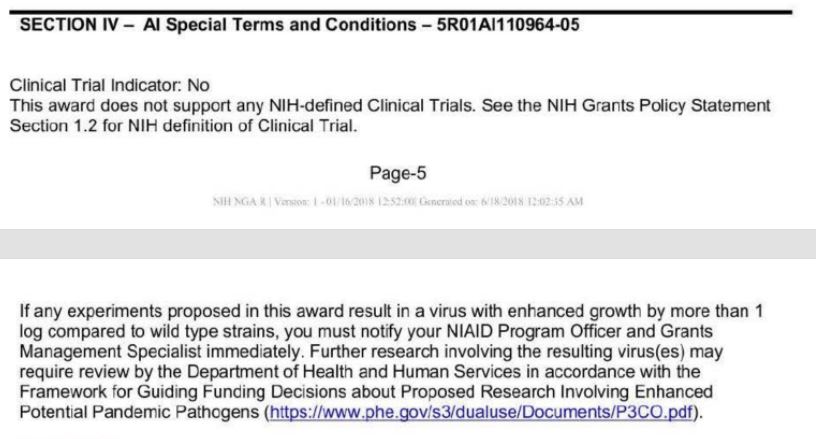by Andrew Kerr
U.S. and Chinese researchers funded by Dr. Anthony Fauci’s National Institute of Allergy and Infectious Diseases (NIAID) created viruses in a Wuhan lab that exhibited over 10,000 times higher viral load in humanized mice than the natural virus they were based on, according to an infectious disease professor citing documents recently released by the agency.
The U.S. nonprofit group EcoHealth Alliance notified the NIAID in two reports that between June 2017 and May 2018 it had created three lab-generated chimeric SARS-related coronaviruses in China that exhibited “significantly higher” viral loads, documents first reported by The Intercept show, but the agency continued to fund the project with taxpayer dollars without flagging it for review by an independent federal committee created in late 2017 to oversee gain-of-function research.
Rutgers University professor Richard Ebright, a vocal opponent of gain-of-function research, said the data was a “bona fide bombshell” that proves the NIAID, under Fauci’s leadership, violated federal policies, endangered the public and lied to the public.
 “Three EcoHealth/[Wuhan Institute of Virology] lab-generated viruses exhibited >10x to >10,000x higher viral load than the starting bat virus in humanized mice,” Ebright tweeted. “One EcoHealth/WIV lab-generated virus exhibited higher pathogenicity than the starting bat virus in infection studies with humanized mice.”
“Three EcoHealth/[Wuhan Institute of Virology] lab-generated viruses exhibited >10x to >10,000x higher viral load than the starting bat virus in humanized mice,” Ebright tweeted. “One EcoHealth/WIV lab-generated virus exhibited higher pathogenicity than the starting bat virus in infection studies with humanized mice.”
“The results demonstrate–unequivocally–a gain in function,” he said.
The results demonstrate–unequivocally–a gain in function.
Based on the results, at least three EcoHealth/WIV lab-generated chimeric viruses are reasonably anticipated–by any rational standard–to enhance transmissibliity or pathogenicity in humans
— Richard H. Ebright (@R_H_Ebright) September 9, 2021
In comparison, the viral load for people infected with the delta variant is roughly 1,000 times higher than those infected with the original strain of the virus, according to Nature science journal.
Ebright added on Twitter that the gain-of-function research activity that NIAID allowed EcoHealth Alliance to conduct in China could have yielded the virus that causes COVID-19 or a progenitor of that virus.
EcoHealth Alliance first notified the NIAID it created the three lab-generated SARS-related coronaviruses in a progress report detailing its research activities between June 2017 and May 2018.
“Using the reverse genetic methods we previously developed, infectious clones with the WIV1 backbone and the spike protein of SHC014, WIV16 and Rs4231, respectively, were constructed and recombinant viruses were successfully rescued,” the group said in its progress report. “2 and 4 days post infection, the viral load in lung tissues of mice challenged with rWIV1-SHC014S, rWIV1-WIV16S and rWIV1-Rs4231S … were significantly higher than that in rWIV1-infected mice.”
“These results demonstrate varying pathogenicity of SARSr-CoVs with different spike proteins in humanized mice,” the report added.
EcoHealth Alliance included a chart visualizing the increased viral load of their lab-created viruses. The chart is presented in a Log scale, meaning each tick of the chart represents a 100-fold increase in viral load in mice with humanized cells, Ebright explained to the Daily Caller News Foundation.

Charts submitted by EcoHealth Alliance to the National Institute of Allergy and Infectious Diseases showing loss of body weight (right) and viral load (left) of mice with humanized cells infected with the natural WIV1 viral strain and three EcoHealth lab-created virus strains. The viral load chart is presented in Log scale, meaning each tic of the graph represents a 100-fold increase in viral load, Rutgers University professor Richard Ebright explained to the DCNF. (Screenshot)
“Each tick in the chart on the right represents an increment of 100x,” Ebright told the DCNF. “The day 4 data show greater-than-10,000x higher viral loads for the lab-generated viruses.”
The viral load for humanized mice infected with the natural virus caught up with the lab-created strains by the end of the experiment, the chart shows, but Ebright said that viral loads in the early stages of an infection are important figures to consider when assessing a pathogen’s transmissibility.
“In terms of assessing potential for transmissibility, the viral load at all time points, particularly at early time points, is relevant. (See Delta variant),” Ebright told the DCNF.
EcoHealth Alliance provided another chart in its progress report showing that humanized mice infected with EcoHealth’s lab-created viruses lost more bodyweight than humanized mice infected with the natural WIV1 strain.
EcoHealth Alliance included the same two charts in a 2018 request to the NIAID requesting additional funding for its research in China, the document trove released by The Intercept shows.
Federal funding for gain-of-function experiments that increase the transmissibility or pathogenicity of potential pandemic pathogens was temporarily suspended in 2014 due to widespread scientific concerns it risked leaking supercharged viruses into the human population.
Funding for gain-of-function research was resumed in late 2017, but only for projects that went through the new Potential Pandemic Pathogens Control and Oversight (P3CO) Framework, which includes a review by an HHS review board tasked with critically evaluating whether grants that involve enhancing dangerous pathogens, such as coronaviruses, are worth the risks and that proper safeguards are in place.
The NIAID opted not to flag the EcoHealth Alliance grant for P3CO after determining on its own accord that the project “did not involve the enhancement of the pathogenicity or transmissibility of the viruses studied,” a National Institutes of Health spokesperson previously told the DCNF.
Fauci said during a congressional hearing in May that the NIH and NIAID “categorically has not funded gain-of-function research to be conducted at the Wuhan Institute of Virology,” a claim that led Republican Sen. Rand Paul of Kentucky in July to send a criminal referral to the Department of Justice to investigate whether Fauci lied before Congress.
The P3CO framework defines an “enhanced” potential pandemic pathogen as any lab-created virus that exhibits any level of boosted transmissibility and/or virulence. Funding agencies such as the NIAID are required to flag any research grant that is “reasonably anticipated to create, transfer, or use enhanced PPPs” for P3CO review.
Despite this, documents released by The Intercept suggest that the NIAID authorized EcoHealth Alliance to conduct gain-of-function experiments on bat coronaviruses up to a certain threshold.
The NIAID informed EcoHealth Alliance in a June 2018 award notice that it must notify the agency only if it creates a virus “with enhanced growth by more than [10 times] compared to wild type strains,” according to documents released by The Intercept. The NIAID linked to the P3CO review process, which contains no such mention of a 10 times allowance, in the very next sentence, the document shows.

NIAID notice to EcoHealth Alliance in June 2018 saying it must notify the agency only if it produces a lab virus that exhibits more than 10 times enhancement over wild-type strains. (Screenshot)
An NIH spokesperson told the DCNF the agency “never approved any research that would make a coronavirus more dangerous to humans.”
“The research we supported in China, where coronaviruses are prevalent, sought to understand the behavior of coronaviruses circulating in bats that have the potential to cause widespread disease,” the spokesperson said. “The body of science produced by this research demonstrates that the bat coronavirus sequences published from that work NIH supported were not SARS-CoV-2. More importantly, because of similar research to understand coronaviruses, we were able to move swiftly to develop vaccines against SARS-CoV-2 and save lives.”
– – –
Andrew Kerr is a reporter at Daily Caller News Foundation.
Photo “Wuhan Institute of Virology” by Ureem2805 CC BY-SA 4.0.








